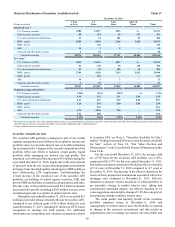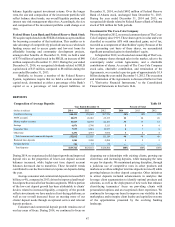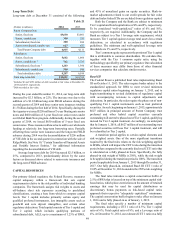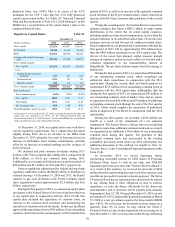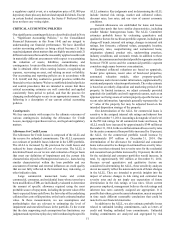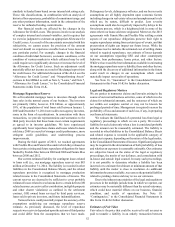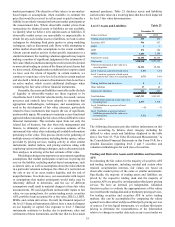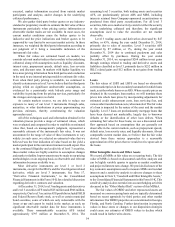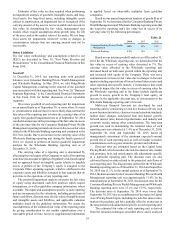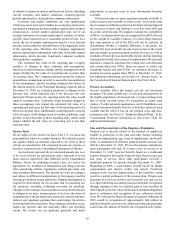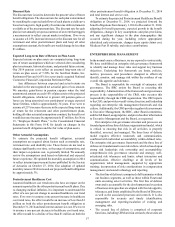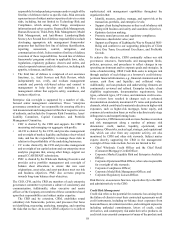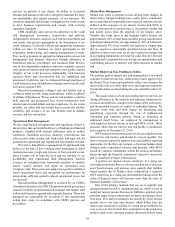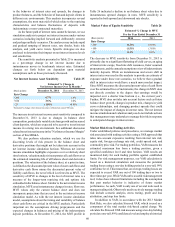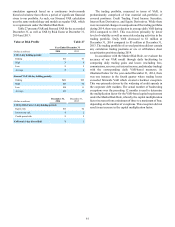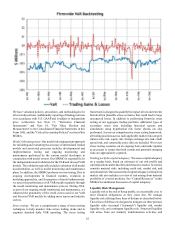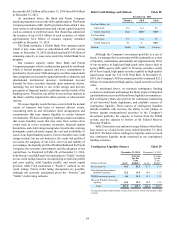SunTrust 2014 Annual Report Download - page 78
Download and view the complete annual report
Please find page 78 of the 2014 SunTrust annual report below. You can navigate through the pages in the report by either clicking on the pages listed below, or by using the keyword search tool below to find specific information within the annual report.
55
Estimates of fair value are also required when performing
an impairment analysis of goodwill, intangible assets, and long-
lived assets. For long-lived assets, including intangible assets
subject to amortization, an impairment loss is recognized if the
carrying amount of the asset is not recoverable and exceeds its
fair value. In determining the fair value, management uses
models which require assumptions about growth rates, the life
of the asset, and/or the market value of the assets. We test long-
lived assets for impairment whenever events or changes in
circumstances indicate that our carrying amount may not be
recoverable.
Other Liabilities
The fair value methodology and assumptions related to our
IRLCs are described in Note 18, “Fair Value Election and
Measurement,” to the Consolidated Financial Statements in this
Form 10-K.
Goodwill
At December 31, 2014, our reporting units with goodwill
balances were Consumer Banking/Private Wealth Management
and Wholesale Banking. In May 2014, we sold RidgeWorth
Capital Management, resulting in the removal of the goodwill
asset associated with that reporting unit. See Note 20, "Business
Segment Reporting," to the Consolidated Financial Statements
in this Form 10-K for further discussion of our reportable
segments.
We review goodwill of each reporting unit for impairment
on an annual basis as of September 30, or more often, if events
or circumstances indicate that it is more-likely-than-not that the
fair value of the reporting unit is below the carrying value of its
equity. Our goodwill impairment test as of September 30, 2014
resulted in an increase in the percentage of the fair value in excess
of the carrying value for the Consumer Banking/Private Wealth
Management reporting unit and a decrease in the excess fair value
related to the Wholesale Banking reporting unit compared to the
2013 test results. Due to an increase in the carrying value of the
Wholesale Banking reporting unit during the fourth quarter of
2014, we elected to perform an interim goodwill impairment
analysis for the Wholesale Banking reporting unit as of
December 31, 2014.
The carrying value of a reporting unit is determined by
allocating the total equity of the Company to each of its reporting
units based on an equal weighting of regulatory risk-based capital
and an approach based on tangible equity relative to tangible
assets. A portion of the Company’s equity is assigned to the
Corporate Other operating segment, which is attributed to the
corporate assets and liabilities assigned to that segment that do
not relate to the operations of any reporting unit.
The goodwill impairment analysis estimates the fair value
of equity using discounted cash flow analyses which require
assumptions, as well as guideline company information, where
available. The inputs and assumptions specific to each reporting
unit are incorporated in the valuations, including projections of
future cash flows, discount rates, the fair value of tangible assets
and intangible assets and liabilities, and applicable valuation
multiples based on the guideline information. We assess the
reasonableness of the estimated fair value of the reporting units
by giving consideration to our market capitalization over a
reasonable period of time; however, supplemental information
is applied based on observable multiples from guideline
companies.
Based on our annual impairment analysis of goodwill as of
September 30, we determined for the Consumer Banking/Private
Wealth Management and Wholesale Banking reporting units that
the respective reporting unit's fair value was in excess of its
carrying value by the following percentages:
Table 24
2014 2013 2012
Consumer Banking/Private Wealth
Management 68% 56% 21%
Wholesale Banking 13% 14% 31%
Based on our interim goodwill analysis as of December 31,
2014 for the Wholesale reporting unit, we determined that the
fair value in excess of carrying value decreased to 7%. The
carrying value allocated to the Wholesale reporting unit
increased based on both asset growth within the reporting unit
and increased total equity of the Company. There was not a
commensurate increase in fair value due to changes in forecast
inputs including expectations of lower forward interest rates and
other reporting unit specific matters. Circumstances that could
negatively impact the fair value in excess of carrying value for
the Wholesale reporting unit in the future include significant
growth in assets, growth in the Company’s total equity, an
increase in the applicable discount rate, or deterioration in the
Wholesale Banking reporting unit’s forecasts.
Multi-year financial forecasts are developed for each
reporting unit by considering several key business drivers such
as new business initiatives, client service and retention standards,
market share changes, anticipated loan and deposit growth,
forward interest rates, historical performance, and industry and
economic trends, among other considerations. The long-term
growth rate used in determining the terminal value of each
reporting unit was estimated at 3.4% as of December 31, 2014,
September 30, 2014 and September 30, 2013, based on
management's assessment of the minimum expected terminal
growth rate of each reporting unit, as well as broader economic
considerations such as gross domestic product and inflation.
Discount rates are estimated based on the Capital Asset
Pricing Model, which considers the risk-free interest rate, market
risk premium, beta, and unsystematic risk adjustments specific
to a particular reporting unit. The discount rates are also
calibrated based on risks related to the projected cash flows of
each reporting unit. The discount rate utilized for the Wholesale
Banking reporting unit as of December 31, 2014 and September
30, 2014 was 11.1%. In the annual analysis as of September 30,
2014, the discount rate for the Consumer Banking/Private Wealth
Management reporting unit was approximately 11.6%. In the
annual analysis at September 30, 2013, the discount rates for the
Consumer Banking/Private Wealth Management and Wholesale
Banking reporting units were 13.1% and 13.3%, respectively.
The discount rates at September 30, 2014 were lower than
September 30, 2013 due to a combination of decreases in Capital
Asset Pricing Model inputs including the risk-free interest rate,
market risk premium, and beta, partially offset by an increase in
the unsystematic risk adjustments specific to each reporting unit.
The estimated fair value of each reporting unit is derived
from the valuation techniques described above and is analyzed



